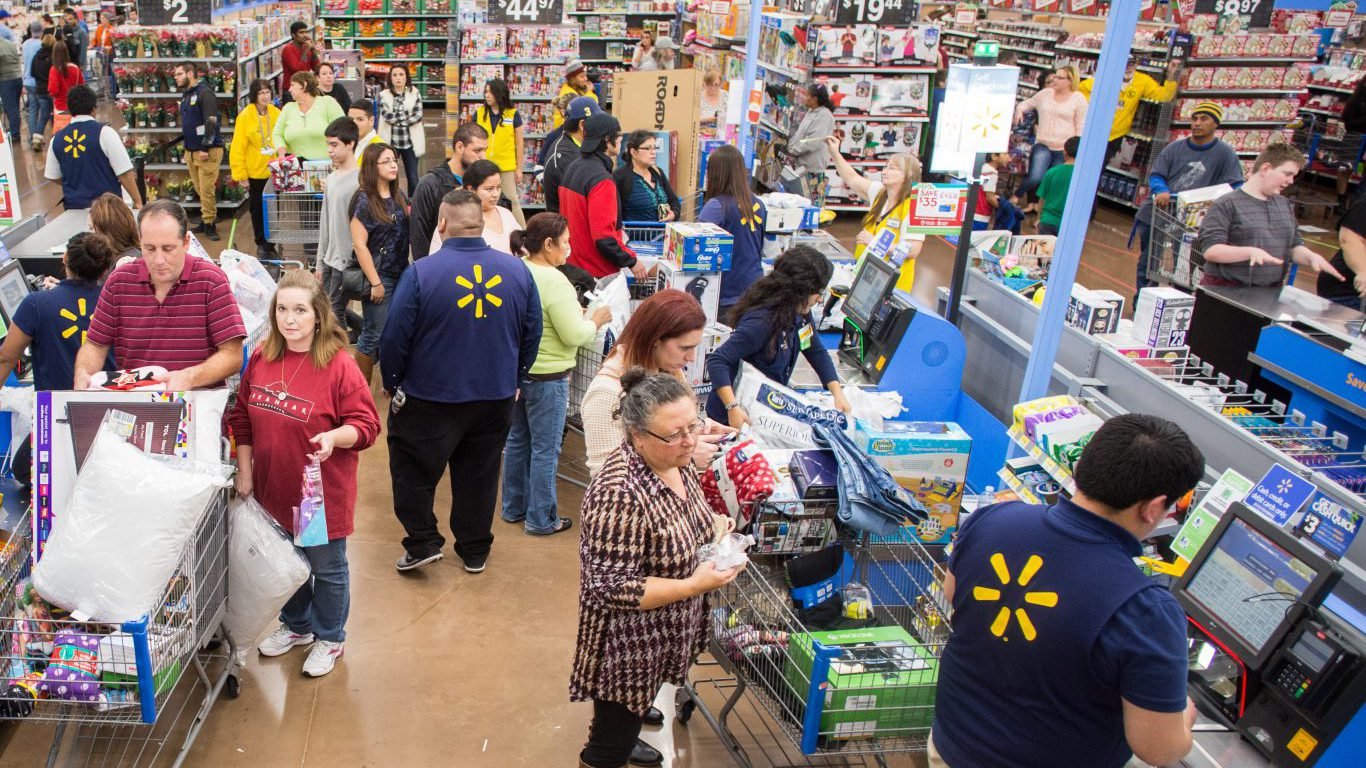

It is hard to imagine that the equity market rally at the end of 2016 was preceded by a weak spot in the economy ahead of the election. Still, that was the case with many companies having weak sales and same-store sales trends on and off in 2016. The good news is that year-end was strong and the rise in consumer confidence after the election has just been too large to ignore.
The Dow Jones Industrial Average closed out 2016 at 19,762.60 on December 30. It may have not hit the elusive 20,000 mark, but it ended the year with a gain of 13.4% from the 17,425.03 close on the last trading day of 2015.
24/7 Wall St. routinely evaluates the potential upside for the Dow and other key stocks. In this quest, we have looked at the mega-retailers in the Dow and a close rival that would have a direct impact on the construction supplies duopoly that exists in America. This puts Wal-Mart Stores Inc. (NYSE: WMT) under the spotlight for 2017 as the world’s largest retailer, and it puts Home Depot Inc. (NYSE: HD) against Lowe’s Companies Inc. (NYSE: LOW) for home improvements and items for the housing sector.
Here is what investors might want to consider about these major retailers as 2017 begins to unfold.
Wal-Mart generated a return of 16% in 2016 with a year-end closing price of $69.12. Its returns in the last month and last quarter of 2016 were rather unimpressive, based in part on a continued tempering of expectations for the world’s largest brick-and-mortar retail stock. Wal-Mart’s consensus analyst price target was $74.59 at year end, for an implied upside potential of 8%. Then there is a 2.9% dividend to consider, so investors might expect a return of 10.9% if those analysts got it right.
The massive retailer didn’t make our preliminary list of the Dogs of Dow, nor our final one, but a 16% return on investment is nothing to sneeze at, especially in the retail sector.
Wal-Mart has been trying, with mixed success, to take a run at Amazon.com Inc. (NASDAQ: AMZN) in the e-commerce space. While the Bentonville, Arkansas, behemoth has little chance of dethroning Amazon, it has carved out a solid number two position.
The company is expanding in Mexico and plans to build more stores internationally, but Wal-Mart has been slow to expand its geographic footprint in the United States.
Wal-Mart has a 52-week trading range of $60.20 to $75.19 and a market cap of $213 billion. Its dividend yield is 2.9%.
Home Depot managed a total return of just 3.5% in 2016, ending at $134.08 on the last trading day in December. All of that seems to have come from a rally late in the year. The consensus target price of $147.04 from Thomson Reuters is actually lower than it was 90 days earlier, but that implies price upside of 11.9%. Then the 2.1% dividend yield would make for a potential total return of 14% in 2017, if the analysts are right.
In mid-December, Oppenheimer reiterated its Outperform rating on the company’s stock, with a price target of $140, somewhat below the consensus target.
Merrill Lynch puts a significantly higher target on Home Depot stock — $158 — than the consensus. Analysts there note that the company’s second quarter is typically its best and pointed out the big push Home Depot made for holiday shoppers dollars.
Home Depot’s third-quarter results beat expectations, posting U.S. same-store sales growth of nearly 6%, and analysts expect fourth-quarter and full-year results to be higher as well.
Home Depot has a 52-week range of $109.62 to $139.00. The market cap is $164 billion, and its dividend yield is 2.0%.
Lowe’s closed out 2016 at $71.12 and generated a negative return of about 5% for shareholders over the course of the year. The consensus target price of $79.79 is down handily in the past 90 days or so, but it still implies an upside of 12.2%. Then the 2% yield could make for a total return of 13.2% in 2017, if the analysts got it right.
The company’s third-quarter results were a real setback after a couple of quarters of decent performance.
Merrill Lynch analysts, however, are more upbeat on the company, citing the sharp price-to-earnings discount compared with rival Home Depot.
Lowe’s has a 52-week range of $62.62 to $83.65 and a market cap of $62 billion. Its dividend yield is 1.9%.
Take This Retirement Quiz To Get Matched With An Advisor Now (Sponsored)
Are you ready for retirement? Planning for retirement can be overwhelming, that’s why it could be a good idea to speak to a fiduciary financial advisor about your goals today.
Start by taking this retirement quiz right here from SmartAsset that will match you with up to 3 financial advisors that serve your area and beyond in 5 minutes. Smart Asset is now matching over 50,000 people a month.
Click here now to get started.
Thank you for reading! Have some feedback for us?
Contact the 24/7 Wall St. editorial team.



